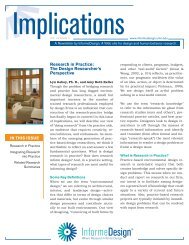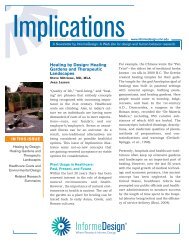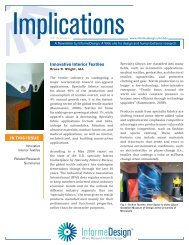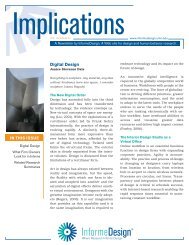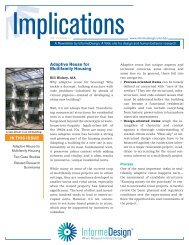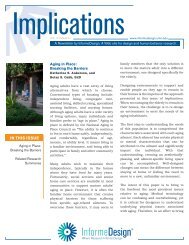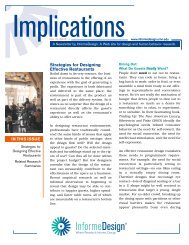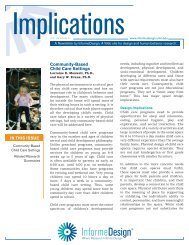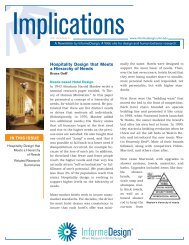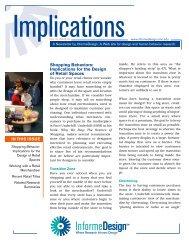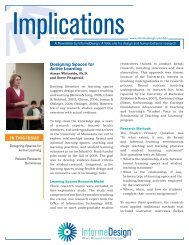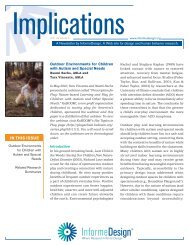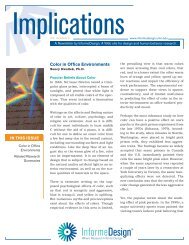Design, Landscape, and Health: Volume 5, Issue 4 - InformeDesign
Design, Landscape, and Health: Volume 5, Issue 4 - InformeDesign
Design, Landscape, and Health: Volume 5, Issue 4 - InformeDesign
Create successful ePaper yourself
Turn your PDF publications into a flip-book with our unique Google optimized e-Paper software.
Implications<br />
www.informedesign.umn.edu<br />
<br />
Decreasing Stress: The Natural Area <strong>and</strong> the<br />
Meditative Area<br />
The viewing of nature is universally associated<br />
with decreased stress <strong>and</strong> a sense of psychological<br />
restoration. A natural area provides a place for<br />
small groups to view an area planted in a more<br />
natural form. The plantings are loosely arranged<br />
but clumped to create visual impact. Plants that attract<br />
wildlife were prioritized as they would increase<br />
the sense of wilderness that the site is intended to<br />
impart.<br />
The meditative area also functions to decrease arousal<br />
<strong>and</strong> stress. Meditative states are associated with<br />
positive physiological states of lowered blood pressure,<br />
pulse, <strong>and</strong> circulating stress hormones. A water<br />
feature was designed to enhance this state by providing<br />
a focus, positive distraction, <strong>and</strong> screening out intrusive<br />
visual <strong>and</strong> auditory stimuli. Conifer plantings<br />
were designed to provide a quiet <strong>and</strong> restful complement<br />
to the space. Their density would create a calm,<br />
enclosed space to facilitate a meditative experience.<br />
The garden walkway.<br />
Exercise: The Garden Walkway<br />
Exercise is associated with relaxation <strong>and</strong> induces a<br />
relaxation response. The site was designed to encourage<br />
walking within the site <strong>and</strong> positive distraction.<br />
The walkways are circular in layout to provide easy<br />
wayfinding for those residents who may suffer from<br />
dementia. The garden walkway plantings were selected<br />
to be bold <strong>and</strong> colorful, to stimulate the senses<br />
in a positive way, <strong>and</strong> to encourage movement to<br />
see what lies ahead. The plantings were designed for<br />
four season interest, shade <strong>and</strong> respite, <strong>and</strong> sheltered<br />
views to the street for “people watching.”<br />
3. Determining the Effectiveness of the <strong>Design</strong><br />
The therapeutic garden can be evaluated through<br />
several disease-specific, biological markers of disease<br />
activity (such as viral loads <strong>and</strong> CD4 counts), <strong>and</strong><br />
measures of mental health status, social functioning,<br />
<strong>and</strong> quality of life. Additionally, it may be useful to<br />
ascertain which areas of the garden are frequented<br />
most often by residents to determine if certain spatial<br />
qualities prove more successful than others in<br />
accomplishing the goals of the design. The hypothesis<br />
is that the installation of the garden will lead to<br />
an improvement in medical, psychiatric, <strong>and</strong> social<br />
indicators among the residents. Measurements of<br />
these health indicators should be made before <strong>and</strong><br />
after installation of the garden to determine what effect,<br />
if any, the garden has upon the health of the<br />
residents.<br />
Toward a New Paradigm of Therapeutic Gardens<br />
As the interest in the field of therapeutic gardens continues<br />
to exp<strong>and</strong>, system for research must be developed.<br />
The chairs of the American Society of <strong>L<strong>and</strong>scape</strong><br />
Architects (ASLA) Therapeutic Garden <strong>Design</strong><br />
Professional Interest Group have stated:<br />
We propose a renewed effort to encourage academic<br />
research that is useful to practitioners, <strong>and</strong> to provide<br />
publicity for the new research to get the word out. Research<br />
is important to validate intuition <strong>and</strong> to motivate<br />
policy change...We need research approaches that<br />
address current problems.<br />
These same sentiments are echoed throughout the<br />
literature <strong>and</strong> writings of l<strong>and</strong>scape architects interested<br />
in this field. And yet, there appears to be little<br />
progress in the answer to these calls.<br />
Where Research Informs <strong>Design</strong>®



